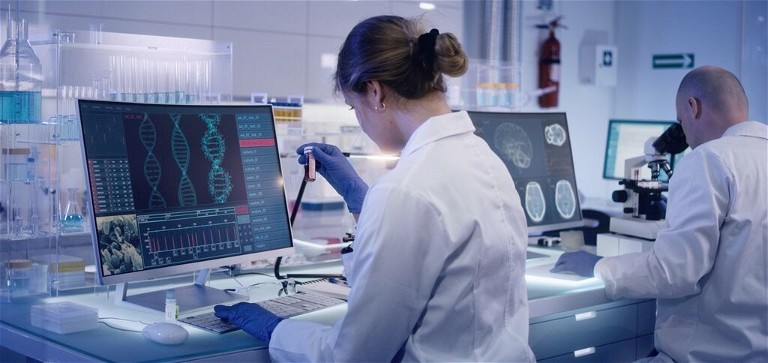Industry Insight
Notable tech-enabled solutions advancing clinical trials with all stakeholders in mind, from patients in need to sites and sponsors
Monika Lamba Saini, Greg Lever and Ashley Polhemus from IQVIA and Q2 Solutions explore digital health technologies and their use in clinical trials

In today’s drug development environment, planning and executing clinical trials with patients in mind is critical to pharmaceutical and biotechnology companies, regulators, site teams and others. However, in aiming to provide patients with a more integrative experience with less burdens to participation, it is important to not overload sites with added responsibilities and/or increase timelines and sponsors’ costs. Incorporating the perspectives of all stakeholders is key to developing effective patient-centred approaches to clinical trials. This is why the broad spectrum of advanced tech-enabled solutions for improving clinical trials from end-to-end is growing by the day, benefiting all stakeholders at some level as they aim to enhance the patient experience.
From improving patient engagement to reducing manual tasks for lab teams and collecting near real-time insights directly from patients for improved disease management, the following examples of innovative technologies show why today’s trial solutions must consider the perspectives of sponsors, sites and patients to improve trial success.
Flexible trial modelling: valuing the patient journey
When diving deeper into understanding the patient journey and its role in trial recruitment, engagement and success, sponsors are dedicating resources to gain valuable insights as to participants’ needs earlier in trial planning through tech-enabled flexible modelling. Advanced analytics capabilities, and tailored artificial intelligence (AI) and machine learning (ML) solutions that are underpinned by qualified expertise are converging to provide granular insights that help improve protocol adherence and chances of trial success, the ultimate benefit for all stakeholders.
There are a few key ways AI-driven analytics can shed light into patient considerations and enhance trial planning.
Trial transparency
As we learned during the COVID-19 pandemic, patients want more transparency about information that impacts their healthcare. As such, the industry has listened and made tangible efforts to break down information silos across the healthcare ecosystem, including for patients who want to proactively engage in clinical research. As we do so, it is vital to help build trust among stakeholders, keep accountability high and ensure accessibility to trial information, such as protocol and data findings, as appropriate. Transparency also creates opportunities to secure feedback from patients, sites and study teams and then make real-time adjustments to trial design.
Using patient-driven insights within data analysis, study teams can gauge and adjust critical trial aspects, including changing dosages, adding treatment arms or removing unnecessary and burdensome tests. But the key is to ensure stakeholders are involved so they may gather intelligence that allows for adjustments as the process continues.
Enhanced creativity in trial elements
The more we understand about patient demographics, therapeutic focus, what patients experience in trials, etc, the better equipped sponsors will be when designing patient-centred trial elements.
For one, flexible modelling allows trial design to change, which ensures the most clinically relevant and accurate data is collected to better inform treatment and care decisions. Since traditional methods cannot produce this level of insight, ML or large-language models can be used to develop new data collection methodologies with heightened sensitivity to patient outcomes and identify patterns that would not be seen otherwise.
Understanding these patterns helps study teams tailor the ways they communicate with patients about trials of potential interest and obtain feedback needed to drive engagement. For example, a study evaluating an investigational cancer treatment used a flexible model to collect data on a variety of patient-reported outcomes, helping researchers better gauge the impact of treatment use on patients’ quality of life.
Digitised pathology: ways to reduce the pathologists’ burden
Traditional lab imaging processes within clinical trials are being revamped through advancements in ultra-speed scanners, high-resolution imaging tools and AI-driven data management strategies. Given there is an industry-wide shortage of experienced pathologists, adopting these tech-enabled diagnostic solutions can help reduce burdens on existing staff and allow them to focus on quality analysis rather than time-intensive manual repetitive tasks.

For example, AI-driven in vitro diagnostics (IVD) tools are increasingly being validated by regulators for patient use (eg, validation via CE marking for IVD use in Europe and US Food and Drug Administration (FDA) approval for algorithms). Pathologists can spend less time on monotonous tasks, such as counting mitosis or performing one-by-one glass slide image analysis, which can be disjointed and slow. Instead, they can help enhance care, especially as digital solutions are allowing them to readily share images within seconds worldwide for second opinions, training and teaching. Also, with digital slides stored on cloud sites and automated collection, storage and processing, experts from anywhere in the world can see these images in seconds without shipping costs and potential damage to fragile glass slides.
Additional tech-enabled improvements for pathologists, include:
• Increased resolution and dimensionality: With AI-based solutions, pathologists can view tissue sections on a molecular level in three-dimensions. These solutions can show tissue at 2X and 200X magnification simultaneously, offering critical measurements (eg, comparisons of tumour nuclear features between cell and tissue types), which provide deeper insights

• Quantity and quality: Manually analysing distances between key elements in tissues can be time-consuming. With computational systems, experts can easily obtain volume measurements to review and compare, helping provide higher throughput. Relational contexts can also be analysed using spatial analytic tools.
Precision oncology: Various advances are helping researchers fight cancer by:
• Providing greater accuracy, reproducibility and standardisation of pathology-based trial entry criteria and endpoints
• Automating calculation and quantification of diagnostic, proliferation and immune biomarkers to help in stratification and prognostication of cancer patients
• Providing earlier detection of cancer or risk predictors and better predicting patient outcomes or phenotypes based on data analysis combining clinical data, imaging and multiomics.
Digital health technologies for therapeutic focus
Wearable technologies and connected devices, including smartwatches, biosensors and varying monitors, are increasing in availability and use within clinical trials. Currently, there are nearly 750 studies in recruitment or active stages evaluating these technologies for a wide range of therapeutic areas and patient groups.1
From glucose monitoring to oxygen levels, digital health technologies (DHTs) can secure vital data directly from patients outside of the clinic, reducing the burden associated with repeated, on-site data collection visits. DHTs are providing flexibility in trial participation, making trials more accessible to patients who are underserved due to geographical or logistical barriers. For sponsors and sites, continuous, remote data collection poses exciting new opportunities in scientific research and patient safety monitoring. The rich data collected from these devices provide unprecedented insights into the health and wellness of clinical trial participants. Depending on trial size, sponsors have the potential to gather millions of data points from a single DHT device. Advancements in analytics and algorithm development subsequently allow study teams to capture deeper insights in near real time to inform smarter decision-making. These tools help sites and patients to continuously monitor patients’ safety and manage disease, which enhances opportunities for improved quality of care.

To effectively evaluate diseases and patient experiences via DHTs, it is vital to consider therapeutic needs and nuances when selecting and incorporating these devices into trials. For starters, a comprehensive and programme-specific digital endpoint strategy is necessary to ensure the study design meets the overall goals and digital endpoints. During study design, the potential tradeoffs between scientific goals, user experience and compliance or data quality must be carefully considered. Sponsors need to strike a careful balance, weighing the capabilities of a DHT against the burden sites and patients may face to use that technology. Sponsors need to ask:
• How extensive or laborious is/are the device(s) to use?
• What are the potential sources of human error or experiences that could impact compliance?
Sponsors need to consider these questions for the full spectrum of participants who are eligible for the trial, as patients’ preferences, digital literacy and physical abilities will differ within and across population subgroups. The technology’s cultural and language compatibility, internet connectivity, suitability across different body types and form factor need to be accounted for as well. Involving patient advocates, scientists and therapeutic experts into trial planning stages is beneficial for gauging which DHT(s) will make the best fit for the specific patient populations and trial needs. Examples include:
• For accurate blood pressure readings, accounting for a wide range of arm circumferences for patient populations and including varying cuff sizes is key
• For patient populations that have reduced dexterity or sense of touch, mobile phones and touch screens without tactile feedback may be difficult to use. In these cases, laptop-based technologies may be preferred
• If patients are required to take devices on and off during the study, it is important that individuals with varying abilities and stature can do this independently. Improper placement of technologies will affect both data quality and patient comfort.

Increasing technology exploration
Like every other industry or aspect of life, clinical trial technologies are continually updated and finessed to meet the needs of key stakeholders, from planning to execution through completion. Whether it is broadening the ways flexible modelling can enhance trial quality and outcomes, cutting-edge imaging and computational approaches to tackle complicated pathology cases or integrating wearables to expand the rich data insights to improve care, the opportunities to enhance drug development for patients are vast and worthy of further exploration.
References
1. Visit: clinicaltrials.gov/search?term =Wearable&aggFilters=status:act%20rec
Monika Lamba Saini MD PhD, director, Pathology, Q2 Solutions has more than 15 years of experience and proficiency in the diagnosis of benign and malignant diseases of different organs, both by cytology and histopathology, incorporating morphology, immunohistochemistry, FISH, cytogenetics and molecular studies. With extensive clinical trial experience, Monika is passionate about the digitisation of pathology and algorithm development for image analysis. Her areas of interest and focus include translational research, transduction pathways, cancer biology, immunopathology, digital pathology, AI, medical writing/publications and public speaking.
Greg Lever, director, AI Solutions Delivery, IQVIA began his career in life sciences and technology more than 13 years ago. After obtaining his PhD at the University of Cambridge, UK, for his work combining quantum physics and machine learning to develop new approaches for small-molecule drug discovery, he worked as a postdoctoral associate at MIT, US. Shifting to industry, Greg was an integral part at several technology startup companies in London and then joined Genomics England in the early stages of the 100,000 Genomes Project, seeing it through project completion. At IQVIA, Greg led a team of ML engineers within the Analytics Center of Excellence. He is now part of the Applied Data Science Center's consulting sales team, helping clients discover innovative ways to bring life-changing therapies to patients faster.
Ashley Polhemus, associate director, User Experience, Connected Devices, IQVIA is the user experience lead in IQVIA’s Connected Devices team, meaning Ashley is responsible for designing and delivering best-in-class experiences for end users of connected devices in clinical trials, including study participants and sites. Ashley has held multiple academic and industry roles related to the design, delivery and validation of digital health products. Before joining IQVIA, Ashley was the product manager for Clinical Trial Connected Devices at MSD (Merck Sharp & Dohme). She has also published over 30 peer-reviewed publications in the realm of digital health, patient engagement, and experience design. Ashley is based in Zurich, Switzerland and has received a Master’s degree in Biomedical Engineering and PhD in Epidemiology.